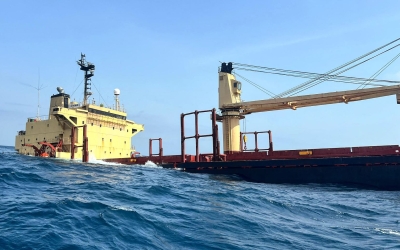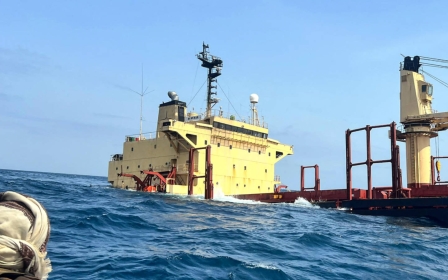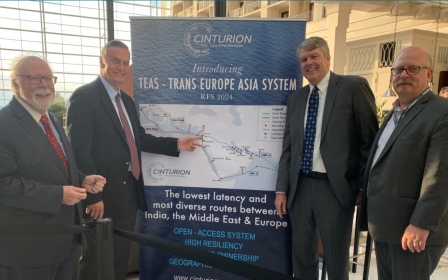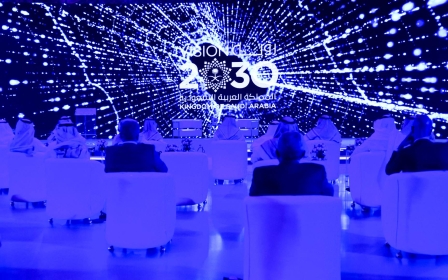Cable firms eye Eritrea as Houthi attacks threaten Red Sea internet traffic
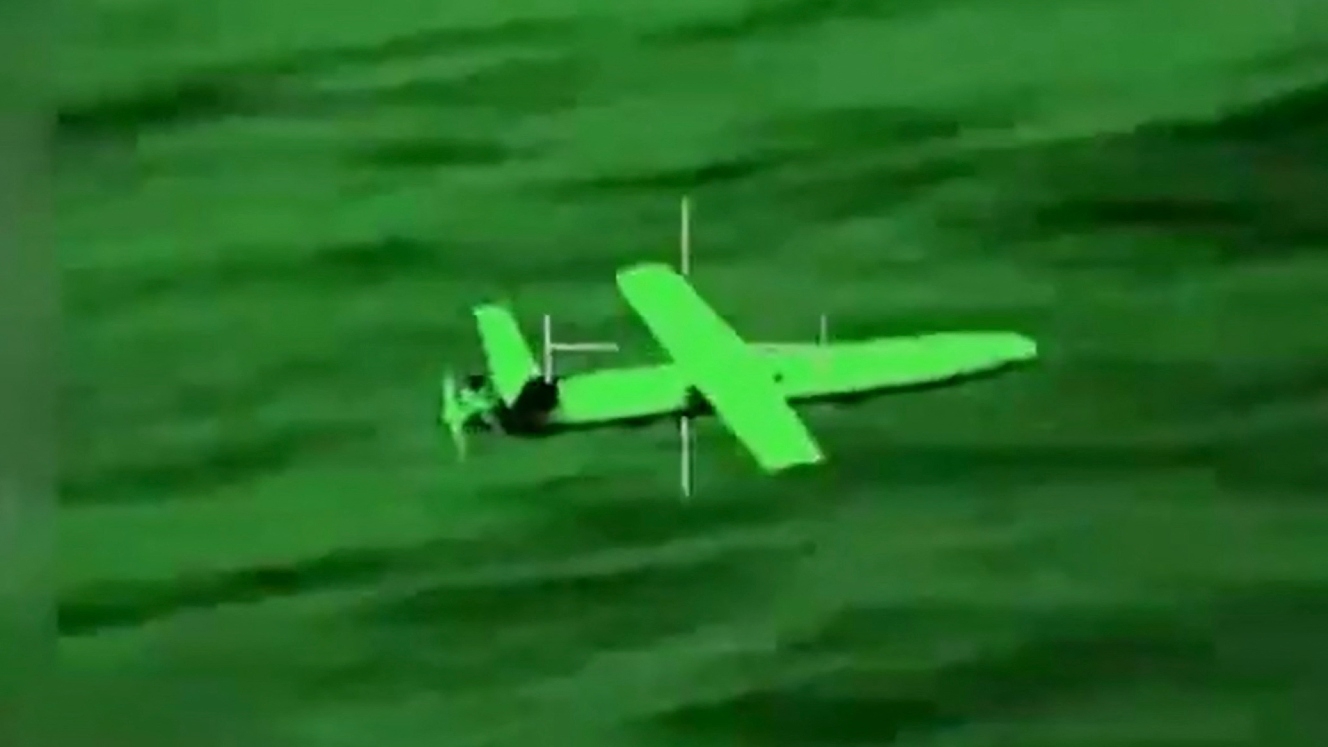
The Red Sea is the top security concern of the global submarine cable industry, with broken cables unable to be repaired or new cables to be laid, causing the industry to scramble to find alternative pathways to keep one of the world’s major internet routes operational.
Since November, Yemen’s Houthis have been targeting shipping linked to Israel’s allies in the Bab al-Mandab strait in response to Israel’s war on Hamas in Gaza.
In early March, three submarine fibre optic cables were cut following a Houthi missile strike on a British-owned vessel, the Rubymar, off the coast of Yemen.
Experts attribute the damage to the crippled ship’s anchor ripping through the cables as it drifted northwards following the attack on 18 February.
Those cables have remained out of service and unreachable on the sea bed, while plans to lay five new cables, which were due to have been laid through the Red Sea to increase capacity, remain on hold.
New MEE newsletter: Jerusalem Dispatch
Sign up to get the latest insights and analysis on Israel-Palestine, alongside Turkey Unpacked and other MEE newsletters
Some firms are now looking to Eritrea as offering a possible route bypassing Yemeni waters along the Red Sea's western shore. But industry insiders say the secretive and autocratic state is not even acknowledging their approaches, with one describing it as a "black hole".
'All cables in the Red Sea go through Yemeni waters, and it highlights the region’s importance for global connectivity'
- Hasnain Ali, analyst
“Any disruption here [in the Red Sea] can have significant repercussions, and has been discussed in the [cable] industry since the events in March. All cables in the Red Sea go through Yemeni waters, and it highlights the region’s importance for global connectivity,” said Hasnain Ali, a director at Pioneer Consulting Middle East, at industry event Submarine Networks in London.
Fifteen cables run through the Red Sea, which handles over 90 percent of all Europe-Asia internet capacity.
While there is spare capacity on the other cables to carry the traffic of the damaged cables, the cables themselves cannot currently be repaired due to the high cost of insuring repair ships as well as a shortage of such vessels worldwide.
AI demand surge
The five new cables, which have been delayed, are needed to meet the surging demand for internet capacity caused by heightened use of AI, cloud storage and the digital drive of Gulf countries to establish new data centres.
Current capacity is some 320 terrabytes of data (Tb), while there is 1,300 Tb planned, according to Ali.
While the situation in the Red Sea is not yet considered a crisis, it has been a wake-up call for the industry and governments, with submarine cables increasingly viewed as critical infrastructure, given they carry over 95 percent of global internet traffic.
“The political risk map [for the cable industry] was academic, now it’s a reality, particularly through Red Sea,” said Rosalind Thomas, managing director and CEO of SAEX International, which is developing a cable from Singapore to the US East Coast via Cape Town, South Africa, avoiding the Red Sea.
The security of cables and associated vessels has been much discussed, said Ugne Kleinauskaite, Meta’s network investments manager for Europe, the Middle East and Africa, at the London conference.
She noted that a cable ship belonging to Emirati telecoms provider Etisalat had gone through the Red Sea twice since March, and that “while it was concerning, it went fine”.
The possibility of stationing a cable repair ship in the Red Sea has been floated by the industry, but would require collective action and be an expensive endeavour, with such a vessel costing up to $20 million.
“It is really complex, and every marine company wants to use their assets [cable laying and repair ships]. None are idle, and are busy until 2028 to 2029,” says Kleinauskaite.
Meta’s 45,000-kilometre 2AFRICA project is the world’s longest subsea cable, connecting Africa, Europe and the Middle East, with the eastern part set to utilise the Red Sea.
Meta has not indicated any changes to its route, but the industry is actively looking at alternative pathways to going through Yemeni waters in the Red Sea.
“Many [cable companies] are stuck, having no visibility to either survey [the sea bed] or lay cables...We are considering everything. It’s all hands on deck [to] explore all the options available until something works,” said Kleinauskaite.
Eritrea: No reply
While the industry is investing in projects that bypass the Red Sea altogether – such as by going overland from the Mediterranean to the Gulf – laying submarine cable is far cheaper and easier.
However, avoiding Yemeni waters is proving problematic as Eritrea is not playing ball despite its maritime waters being at an optimal depth, of around 170 metres, for cables to be laid.
'Typically if you ask governments for permission [to lay cables] they say yes or no, but the Eritreans simply don’t reply. It’s a black hole'
- Hasnain Ali, analyst
Eritrea is one of the few countries in the world not to have signed the United Nations Convention on the Law of the Sea (UNCLOS), and has rebuffed the approaches of the cable industry to use its waters, even at a price.
“Typically if you ask governments for permission they say yes or no, but the Eritreans simply don’t reply. It’s a black hole, and is an issue for everybody in the industry to deal with,” said Ali.
With Eritrea off limits, cable companies are having to deal with the dual governments of Yemen. For the past decade, much of the country has been under the control of the Houthis, with the country's internationally recognised government based in Saudi Arabia.
Cable companies are hoping that the Houthis call off attacks on shipping lanes, but the group has remained steadfast in its support for Palestinians, despite themselves facing a campaign of American and British air strikes since January.
Following a US-British air strike on Yemen in late May, Houthi official Mohamed al-Bukhaiti wrote on his X account: “The American-British aggression will not prevent us from continuing our military operations in support of Palestine… We will meet escalation with escalation.”
A UN peace plan adopted by Yemen’s warring parties in December may also be blocked by the US, which has demanded the Houthis stop attacks on maritime routes, reported Bloomberg last week.
“Yemen is a permit and security challenge for the industry as a whole. Over the last few months its been trickier to deal with the Houthis than it used to be. They’ve shown a more aggressive approach in dealing with any foreign company, either to get permission [to lay cables] or for maintenance approvals,” said Ali.
It is not just Yemeni waters that are causing security concerns. The Houthis, in cooperation with the Islamic Resistance in Iraq, claimed they launched attacks against ships at Israel's Haifa port in early June, while there was also an attack on Eilat in late May.
Tirat Hacarmel, near Haifa, is a major fibre-optic cable landing station for Israel, as is the southern port city.
The Red Sea cable situation is seen by some as an opportunity however.
'The Red Sea issue has pros and cons. Every problem has an opportunity. We’ve been talking for years, reflecting on the need for other routes'
- Rashid Ali al-Ali, senior vice president e&
“The Red Sea issue has pros and cons. Every problem has an opportunity. We’ve been talking for years, reflecting on the need for other routes," said Rashid Ali al-Ali, a senior vice president at Emirati telecoms company e&.
"I’m not saying it’s good what is happening [in the Red Sea] but it is raising a red flag to speed up other routes."
"Finding a crossing to avoid Egypt was key, now it is the Red Sea. The timing [for such a] project is perfect."
The developer of such a cable, Cinturion's 20,000-kilometre Trans Europe Asia System (TEAS), which is intended to run through the Mediterranean to land at Tirat Hacarmel, then cross overland to Jordan and Saudi Arabia – a first for the region - said the timing “was not perfect”.
“The challenge has been when integrating terrestrial cable into two subsea systems at either end [of the project, between Israel and the Gulf],” said Greg Varisco, CEO of the Bermuda-based Cinturion Group, at the London event.
With terrestrial cables an anomaly worldwide, with 95 percent - 1.4 million kilometres - laid under the sea, and none running across the Arabian Peninsula, regional regulators have had to be persuaded of the potential benefits of installing land-based cables.
“They freak out, and we have to explain it. It has been a learning process in the region, and has definitely had an impact on how quickly we get permits,” Varisco said.
Saudi-Emirati-Israeli land route
For the terrestrial route, Cinturion had been “sniffing out engineering expertise,” he said.
Permission to land the TEAS cable in Saudi Arabia has been submitted to the regulator. “It is the last permit, in principle, needed to go forward,” Varisco said.
Cinturion, which has investors from Israel, the US, the UK, and the Gulf, has secured financing from the World Bank and its investment arm, the International Finance Corporation (IFC). It has already signed landing cable agreements with Israel’s Tamares telecoms, as well as with the United Arab Emirates.
Varisco would not comment to MEE on the make-up of the cable’s investors. “We want to focus on us as developers,” he said.
Neither would he comment on the need for a normalisation deal between Israel and Saudi Arabia, similar to the Abraham Accords signed by the UAE and Bahrain in 2020, to ensure the laying of the TEAS cable.
“We deal with each country and each regulator separately. It is a system for multiple countries, and not concerned by each country,” he said.
Saudi and Israeli involvement in the project has not garnered wide attention even though it would be the first direct physical infrastructure connection between the two countries.
Varisco said that Saudi Arabia “understands it is part of global communications… to say it’s not part of the world is a bit weird”.
He said Cinturion was “trying to support Saudi Arabia. They are quiet and conservative, and don’t want to interrupt the digital transition [going on in the country], which is amazing”.
Middle East Eye delivers independent and unrivalled coverage and analysis of the Middle East, North Africa and beyond. To learn more about republishing this content and the associated fees, please fill out this form. More about MEE can be found here.


